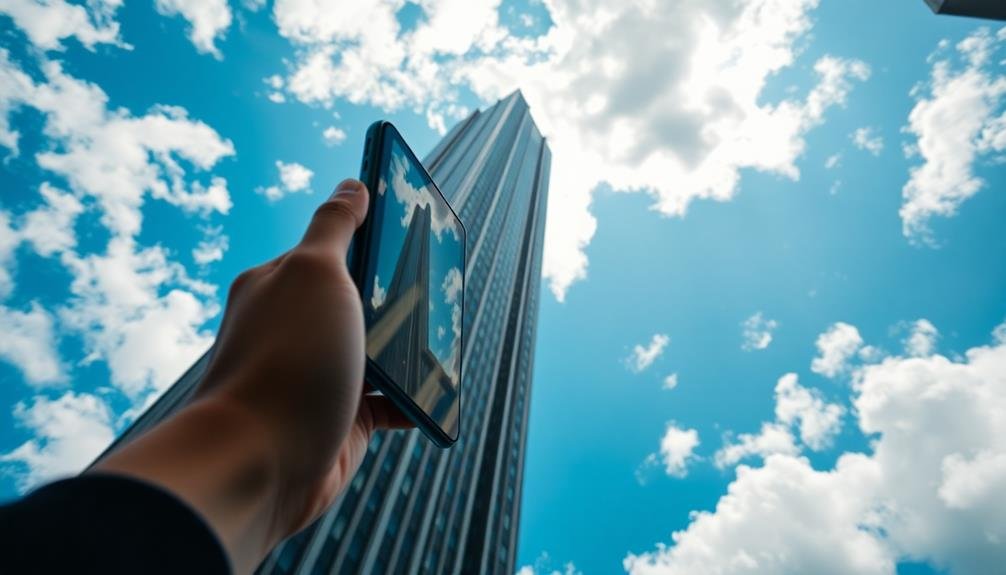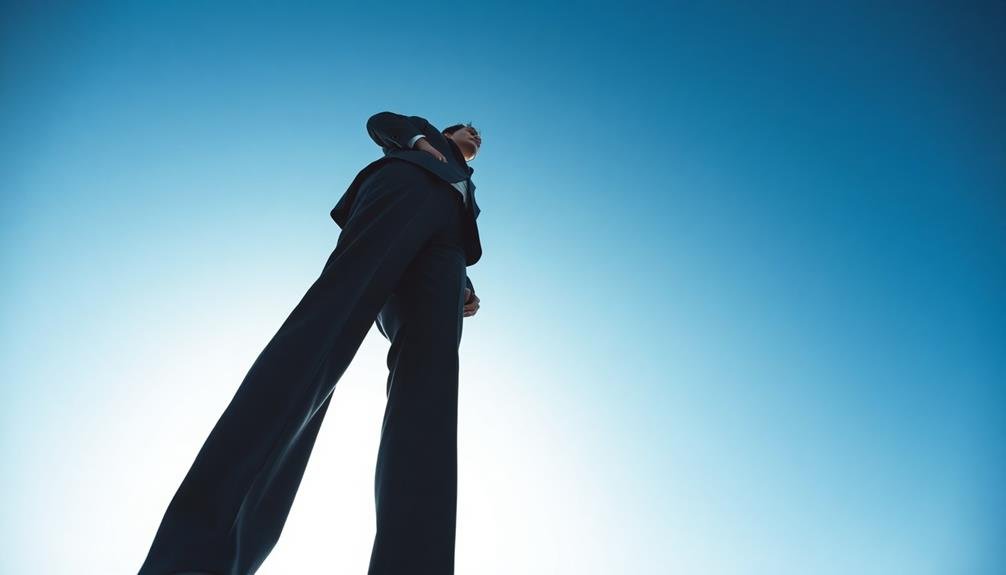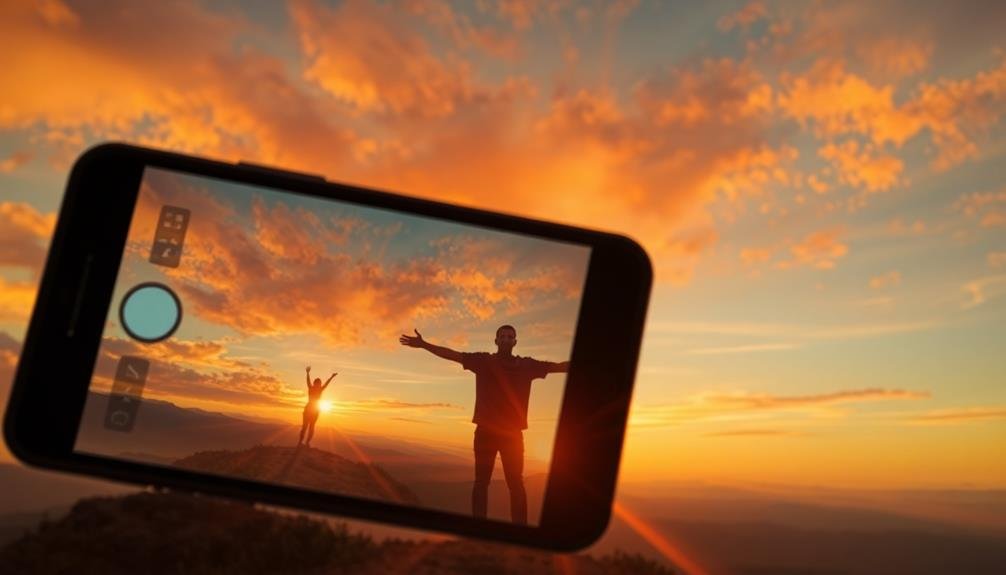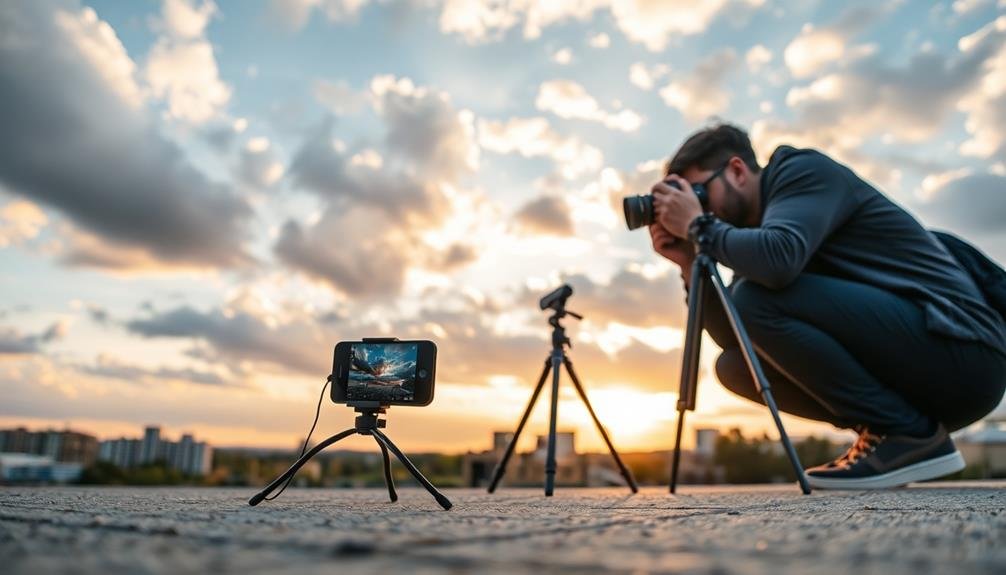Low angle photography can transform your ordinary phone shots into striking images. By positioning your camera close to the ground, you'll create a unique perspective that makes subjects appear larger and more imposing. This technique adds depth and interest to your photos, emphasizing foreground elements and altering spatial relationships. You'll capture interesting textures, patterns, and leading lines that guide the viewer's eye. Framing subjects against the sky creates dramatic contrast, while highlighting unexpected details in the foreground adds visual allure. With practice, you'll master this powerful technique to elevate your smartphone photography and see the world from a fresh, intriguing viewpoint.
Understanding Low Angle Photography

Crouching down with your smartphone, you'll discover a whole new perspective in low angle photography. This technique involves positioning your camera close to the ground, looking upward at your subject. It's a powerful way to create dramatic, impactful images that stand out from typical eye-level shots.
Low angle photography alters the viewer's perception, making subjects appear larger, more imposing, or more significant. It can add a sense of grandeur to landscapes, architecture, and even portraits. You'll find that this approach often introduces unique foreground elements, adding depth and interest to your compositions.
When shooting from a low angle, pay attention to the sky or ceiling as your new background. This can dramatically change the mood of your image. You'll also need to be mindful of distortion, especially when photographing people or buildings. Experiment with different heights to find the sweet spot that enhances your subject without creating unflattering angles.
To master low angle photography, practice is key. Try various subjects and scenarios, from cityscapes to nature shots. You'll soon develop an eye for when this technique can transform an ordinary scene into an extraordinary photograph.
Benefits of Low Angle Shots

Low angle shots offer a wealth of creative possibilities for smartphone photographers. By positioning your camera below eye level, you'll capture subjects from a unique perspective that can dramatically alter the mood and impact of your images. These shots can make objects appear larger, more imposing, or more significant than they are in reality.
When you're shooting portraits, low angles can create a sense of power and authority for your subject. In landscape photography, they can emphasize foreground elements and create a more immersive experience for viewers. You'll also find that low angles can reveal textures and details that might be missed from a standard eye-level perspective.
Here's a quick overview of low angle benefits across different photography genres:
| Genre | Benefit 1 | Benefit 2 | Benefit 3 |
|---|---|---|---|
| Portraits | Convey authority | Elongate subjects | Unique perspective |
| Landscapes | Emphasize foreground | Create depth | Dramatic skies |
| Architecture | Accentuate height | Showcase details | Imposing structures |
| Street | Fresh viewpoint | Highlight textures | Intriguing compositions |
Emphasizing Subject Height and Power

When you shoot from a low angle, you'll create a towering subject perspective that instantly magnifies your subject's presence.
This technique can make even average-height individuals appear taller and more imposing in your photos.
Towering Subject Perspective
Ever wondered how to make your subject appear larger than life in your smartphone photos? The towering subject perspective is your secret weapon. By shooting from a low angle, you'll create a dramatic effect that exaggerates your subject's height and presence.
To achieve this, get down low and tilt your phone upwards. This angle forces the viewer to look up at the subject, making them appear taller and more imposing. It's particularly effective for architectural shots, portraits of people or animals, and even photographs of objects.
When using this technique, pay attention to your composition. The subject should dominate the frame, often extending beyond the top edge. This cropping further enhances the sense of scale and grandeur.
Experiment with different distances from your subject to find the sweet spot that maximizes the towering effect without distorting the image too much.
Monumental Presence Creation
Building on the towering subject perspective, monumental presence creation takes your low-angle photography to the next level. By emphasizing your subject's height and power, you'll transform ordinary scenes into awe-inspiring images. Position yourself at ground level or even lower, tilting your phone upwards to capture your subject's full stature.
This technique works wonders for architectural shots, making buildings appear to scrape the sky. It's equally effective for portraits, lending an air of authority and dominance to your subject. You'll find that even everyday objects can take on a larger-than-life quality when photographed from below.
To truly master monumental presence creation, experiment with different angles and distances. The closer you are to your subject, the more dramatic the effect will be. Don't be afraid to get creative with your compositions – try including foreground elements to add depth and scale to your images.
| Subject | Emotion Evoked |
|---|---|
| Skyscrapers | Awe |
| Statues | Reverence |
| Trees | Wonder |
| People | Power |
| Landmarks | Pride |
Creating Unique Perspectives

When you shoot from a low angle, you'll create unique perspectives that can transform ordinary scenes into extraordinary images.
By positioning your phone close to the ground, you'll emphasize your subject's prominence and enhance the dramatic effect of your composition.
This technique also alters spatial relationships, making objects appear larger and more imposing, which can add intrigue and visual interest to your photos.
Emphasize Subject's Prominence
Low-angle shots offer a powerful way to emphasize your subject's prominence and create unique perspectives in phone photography. By positioning your camera below eye level, you'll instantly make your subject appear larger and more imposing. This technique works especially well for portraits, architecture, and nature shots.
When shooting people, a low angle can make them seem taller, more authoritative, or even heroic. It's an excellent choice for capturing leaders, athletes, or anyone you want to portray as strong and confident.
For buildings and structures, low angles accentuate their height and grandeur, creating a sense of awe and scale.
In nature photography, try getting close to the ground to capture flowers, insects, or small animals. This perspective will make them appear larger than life and reveal details you might miss from a standing position.
You can also use low angles to include interesting foreground elements, adding depth to your compositions.
To achieve the best results, experiment with different heights and angles. Get creative by placing your phone on the ground or using props to stabilize it at various low positions.
Remember to focus on your subject and consider the background to guarantee a balanced composition.
Enhance Dramatic Effect
Beyond emphasizing prominence, low-angle shots can greatly enhance the dramatic effect of your phone photos. By positioning your camera close to the ground, you'll create a unique perspective that adds depth and intrigue to your images. This technique works especially well for architectural shots, making buildings appear more imposing and grand.
When shooting people, a low angle can make your subject look more powerful and authoritative. It's an excellent choice for portraits of leaders or athletes.
For nature photography, try capturing flowers or small animals from ground level. You'll reveal details often missed from a standing position and create a more immersive experience for viewers.
To maximize the dramatic effect, experiment with different angles. Tilt your phone slightly upward to exaggerate the height of tall objects. For added impact, include foreground elements to create layers in your composition. This technique works well in urban settings, where you can use street textures or objects to frame your main subject.
Don't be afraid to get dirty. Lying on the ground or crouching low will give you access to perspectives that most photographers overlook, resulting in truly unique and striking images.
Alter Spatial Relationships
Spatial relationships in photography can be dramatically altered through low-angle shots. When you shoot from below, you're changing how objects in the frame relate to each other and their surroundings. This perspective shift can make familiar scenes appear entirely new and intriguing.
By positioning your phone close to the ground, you'll create a sense of depth that's often missing in eye-level shots. Foreground elements become more prominent, seeming larger and more imposing. This technique can make ordinary objects appear monumental or even abstract.
You'll also notice that low angles can separate subjects from their backgrounds more effectively. A person shot from below might suddenly tower against the sky, divorced from their usual context. This isolation can add emphasis and create a powerful visual impact.
Don't forget to experiment with different focal lengths. Wide-angle lenses will exaggerate the low perspective, while telephoto settings can compress the scene, creating unique spatial relationships between distant objects.
As you practice, you'll discover how slight adjustments in camera position can dramatically alter the perception of space and scale in your photos.
Capturing Interesting Foregrounds

When you're shooting from a low angle, the foreground becomes an essential element of your composition. By getting close to the ground, you'll find new and exciting objects to incorporate into your frame. Look for textures, patterns, or small details that might go unnoticed from a standing position. Blades of grass, pebbles, flowers, or even cracks in the pavement can add depth and interest to your photos.
Consider using these foreground elements to lead the viewer's eye towards your main subject. You can create a sense of depth by focusing on a nearby object while allowing the background to blur slightly. This technique, known as forced perspective, can make your subject appear larger or more imposing.
Don't be afraid to experiment with different foreground elements. Try placing your phone near reflective surfaces like puddles or mirrors to capture unique reflections.
You can also use contrasting colors or shapes in the foreground to create visual tension and draw attention to your subject. Remember, the key is to find a balance between an interesting foreground and your main subject, enhancing the overall impact of your low-angle shot.
Enhancing Depth in Landscapes

Low-angle photography can breathe new life into landscape shots by enhancing depth and creating a more immersive experience. When you position your phone close to the ground, you'll capture foreground elements in greater detail, adding layers to your composition.
This technique forces the viewer's eye to travel through the image, from the close-up elements to the distant horizon.
To enhance depth in your landscape photos using low angles:
- Use leading lines from the foreground to guide the viewer's gaze
- Include interesting textures or patterns in the immediate foreground
- Frame your shot with natural elements like rocks, flowers, or grass
- Experiment with different focal lengths to alter perspective
- Incorporate reflections in water or other surfaces for added dimensionality
Highlighting Textures and Patterns

One of the most striking advantages of low-angle phone photography is its ability to highlight textures and patterns that often go unnoticed. When you lower your phone close to a surface, you'll capture intricate details that are usually overlooked from a standing position. This technique works wonders on various surfaces like cobblestones, sand, grass, or even wooden decks.
To make the most of this approach, focus on finding interesting textures in your surroundings. Look for repetitive patterns, contrasting materials, or unique surface qualities. Once you've identified a compelling texture, position your phone just inches away from it.
Experiment with different angles to see how light interacts with the surface, creating shadows and highlights that enhance the texture's appearance. You can also use this technique to create visually striking compositions.
Try aligning patterns with your frame's edges or using the texture as a leading line to guide the viewer's eye. Don't be afraid to play with your phone's exposure settings to emphasize the contrast between light and shadow, further accentuating the texture's details.
Utilizing Leading Lines Effectively

When shooting from low angles, you'll find that leading lines become even more powerful.
You can use these lines to create a strong sense of depth in your images, drawing the viewer's eye into the scene.
Emphasize Depth Perception
Photographers know that leading lines can transform a flat image into a dynamic composition with enhanced depth perception.
When shooting from a low angle, you'll find that these lines become even more prominent, guiding the viewer's eye through the frame and creating a sense of distance and scale.
To emphasize depth perception in your low-angle phone photos, consider these techniques:
- Use foreground elements to frame your subject
- Incorporate converging lines that lead to your focal point
- Leverage natural patterns in the environment
- Experiment with different perspectives to find the most compelling angle
- Play with shadows to add dimensionality
Guide Viewer's Attention
Leading lines are powerful tools for guiding your viewer's attention in low-angle phone photography. When you shoot from a low perspective, you can easily incorporate natural lines in your composition.
Look for paths, roads, fences, or building edges that stretch from the foreground to the background. These elements create a visual journey for the eye to follow, drawing the viewer into the image.
To use leading lines effectively, position your phone so that these lines start at the bottom corners or edges of your frame. They should converge towards your main subject or a point of interest in the distance. This technique not only directs attention but also adds depth and dimension to your photo.
Don't limit yourself to straight lines; curved or winding paths can be just as effective. They add a sense of movement and flow to your image.
Remember, the goal is to create a visual narrative that guides the viewer's gaze through the photo. Experiment with different angles and compositions to find the most compelling arrangement of leading lines.
Framing Subjects Against the Sky

One of the most striking ways to utilize low-angle photography on your phone is by framing subjects against the sky. This technique creates a dramatic contrast between the subject and the vast expanse above, making your images more engaging and memorable.
When you position your phone low to the ground and angle it upwards, you'll immediately notice how your subject appears larger and more imposing against the sky. This perspective can transform ordinary objects into extraordinary focal points. Trees, buildings, sculptures, and even people can take on a whole new dimension when framed this way.
To make the most of this technique, consider the following tips:
- Look for interesting cloud formations to add texture
- Experiment with different times of day for varied sky colors
- Use the rule of thirds to position your subject off-center
- Incorporate silhouettes for added drama
- Play with negative space to emphasize your subject
Avoiding Common Low Angle Mistakes

While low-angle photography can produce stunning results, it's easy to fall into common pitfalls that diminish the impact of your shots. One frequent mistake is tilting your phone too far, creating an extreme angle that distorts your subject unnaturally. Instead, aim for a subtle tilt that enhances perspective without warping the image.
Another error is failing to take into account the background. When shooting from below, you might inadvertently include distracting elements like trash cans or parked cars. Always scan the entire frame before taking your shot.
Don't forget about lighting; harsh overhead sun can create unflattering shadows on faces when shooting from below. Try to position your subject so that light falls evenly across their features.
Many photographers also neglect composition rules when experimenting with low angles. Remember to apply principles like the rule of thirds and leading lines to create balanced, visually appealing images.
Essential Low Angle Photography Gear

Now that you're aware of common pitfalls, let's focus on the gear that can elevate your low-angle phone photography.
While your smartphone is the primary tool, a few accessories can greatly enhance your low-angle shots. A compact tripod is essential for stability, allowing you to position your phone close to the ground without wobbling.
Consider investing in a flexible tripod with adjustable legs for versatile placement on uneven surfaces.
A remote shutter release, whether wireless or wired, helps you trigger the camera without touching your phone, reducing camera shake.
For even more creative control, look into clip-on lenses that can expand your phone's capabilities, such as wide-angle or macro options.
Here's a list of essential gear for low-angle phone photography:
- Compact or flexible tripod
- Remote shutter release
- Clip-on lenses (wide-angle, macro)
- Smartphone gimbal for smooth motion shots
- Waterproof case for ground-level shots in wet conditions
Frequently Asked Questions
How Do Low Angle Shots Affect Image Stabilization on Smartphones?
You'll find low-angle shots can challenge your phone's image stabilization. They often require you to hold your device in less stable positions, making it harder for built-in stabilization features to compensate for hand movements and vibrations.
Can Low Angle Photography Be Effectively Combined With HDR Techniques?
You can absolutely combine low angle photography with HDR techniques. It'll enhance contrast and detail in your shots, especially when capturing scenes with bright skies and darker foregrounds. Experiment with different angles to maximize HDR's impact.
Are There Specific Editing Apps Best Suited for Low Angle Phone Photos?
You'll find apps like Snapseed, VSCO, and Adobe Lightroom Mobile particularly useful for low angle phone photos. They offer tools to enhance perspective, adjust contrast, and fine-tune details that make your unique shots stand out even more.
How Does Lens Focal Length Impact Low Angle Shots on Smartphones?
Your smartphone's focal length affects low angle shots considerably. Wider lenses (shorter focal lengths) exaggerate perspective, making subjects appear larger and more dramatic. Longer focal lengths compress the scene, reducing distortion but potentially limiting the impact of low angles.
What Are the Ethical Considerations When Taking Low Angle Photos of People?
You should always respect privacy and dignity when taking low angle photos of people. Don't capture unflattering or compromising angles without consent. Consider how you'd feel if someone took similar shots of you without permission.
In Summary
You've now explored the world of low-angle phone photography. By getting down low, you'll create striking images that emphasize height, offer unique perspectives, and frame subjects dramatically. Remember to use leading lines, capture interesting foregrounds, and avoid common pitfalls. With practice and the right gear, you'll master this technique. Don't be afraid to get dirty – the results are worth it. So grab your phone, crouch down, and start shooting from a whole new angle!





Leave a Reply